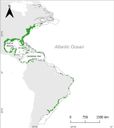Callinectes
Callinectes
Classification
- Phylum: Arthropoda
- Subphylum: Crustacea
- Class: Malacostraca
- Superorder: Eucarida
- Order: Decapoda
- Infraorder: Brachyura
- Family: Portunidae
- Genus: Callinectes
Pronunciation
How to pronounce Callinectes: /ˌkæ.lɪˈnɛk.tiːz/
These audio files are automatically generated. While they are not always 100% accurate, they are a good starting point.
Images






Summary
Callinectes sapidus, commonly known as the blue crab, is a commercially important species found in the western Atlantic and Gulf of Mexico. They have distinct physical characteristics, a complex reproductive cycle, and face challenges including overfishing and habitat loss.
Physical Characteristics
Blue crabs may grow to a carapace width of 23 cm (9 in). Males have long and slender abdomens, while females exhibit wide, rounded abdomens. The immovable claw of males is blue with red tips, while females have orange coloration with purple tips.
Identification Tips
Males and females can be distinguished by their abdominal shape (male is long and slender, female is wide and rounded) and claw coloration (males have blue claws with red tips, females have orange claws with purple tips).
Habitat
Blue crabs inhabit high-salinity coastal waters, estuaries, and the mouths of rivers. They often inhabit brackish waters.
Distribution
C. sapidus is native to the western Atlantic Ocean from Cape Cod to Argentina, and around the Gulf of Mexico. It has been introduced to various international waters including the Baltic, North, Mediterranean, and Black Seas.
Diet
C. sapidus is an omnivore, consuming thin-shelled bivalves, crustaceans, annelids, small fish, marine plants, carrion, and other organic matter.
Life Cycle
Eggs hatch in high-salinity waters, progressing through several planktonic stages before settling into brackish waters as juvenile crabs. Blue crabs undergo molting about 25 times during their lifespan, with variable growth rates influenced by environmental factors.
Reproduction
Males may mate multiple times, while females mate only once. After mating, inseminated females carry fertilized eggs in a sponge before releasing them into high salinity waters for hatching. Females can produce up to 2 million eggs per brood.
Predators
Natural predators include eels, drum fish, striped bass, some sharks, humans, and cownose rays.
Ecosystem Role
C. sapidus plays a role in controlling populations of smaller fish and invertebrates. They may impact the populations of invasive species, such as the green crab.
Economic Impact
C. sapidus is of considerable culinary and economic importance in regions like Chesapeake Bay. They are a major fishery resource, with significant commercial harvests.
Cultural Significance
The blue crab is the state crustacean of Maryland and has cultural significance in various regional cuisines and fishing traditions.
Health Concerns
Some studies have found organochlorides, such as DDT, accumulating in C. sapidus. They can also carry parasites and diseases.
Collecting Methods
- Trotline
- Crab pots
- Dip nets
Preservation Methods
- Refrigeration techniques
- Freezing
Similar Taxa
Misconceptions
There may be confusion between different species of Callinectes due to their similar morphology and overlapping ranges.
Tags
- crab
- Marine Biology
- Commercial Fishery
- Ecology
- Culinary